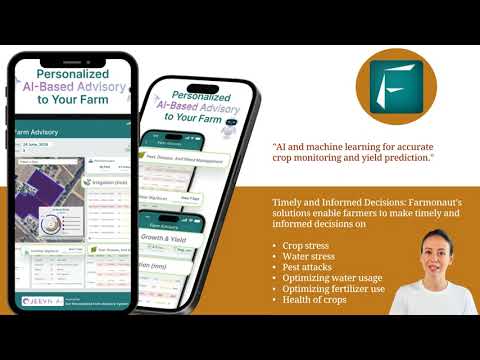Optimize Your Farm’s Profitability: Precision Agriculture Techniques for Managing Soaring Fertilizer Costs in Australia

In the ever-evolving landscape of Australian agriculture, farmers face a significant challenge: managing soaring fertilizer costs while maintaining crop yields and profitability. At Farmonaut, we understand the importance of precision agriculture techniques and fertilizer cost management in modern farming success. That’s why we’ve developed this comprehensive guide to help you navigate these challenges and optimize your farm’s performance.
“Precision agriculture techniques can help farmers reduce fertilizer costs by up to 30% while maintaining crop yields.”
In this blog post, we’ll explore three innovative strategies that can revolutionize your agricultural practices and help you make data-driven farming decisions. From soil sampling for crop optimization to implementing on-farm fertilizer trials and leveraging digital farming tools, we’ll show you how to maximize your agricultural ROI while embracing sustainable agriculture practices.
The Importance of Precision Agriculture in Managing Fertilizer Costs
Before we dive into the specific techniques, let’s understand why precision agriculture is crucial for managing fertilizer costs in Australia:
- Resource Efficiency: Precision agriculture allows for targeted application of fertilizers, reducing waste and optimizing input use.
- Cost Savings: By applying fertilizers only where and when needed, farmers can significantly reduce their input costs.
- Environmental Sustainability: Efficient fertilizer use minimizes environmental impact and promotes sustainable farming practices.
- Improved Crop Performance: Tailored fertilizer application based on precise data leads to better crop health and yields.
- Long-term Profitability: By optimizing inputs and outputs, precision agriculture contributes to sustained farm profitability.
Now, let’s explore the three key precision agriculture techniques that can help you manage soaring fertilizer costs and optimize your farm’s profitability.
1. Soil Sampling for Crop Optimization
Soil sampling is a fundamental practice in precision agriculture that provides crucial insights into your field’s nutrient status. By understanding the specific needs of your soil, you can make informed decisions about fertilizer application, potentially saving significant costs while optimizing crop performance.
The Process of Soil Sampling
- Field Zoning: Divide your field into manageable zones based on factors like topography, soil type, and historical yield data.
- Sample Collection: Collect soil samples from each zone, ensuring they represent the area accurately.
- Laboratory Analysis: Send samples to a reputable soil testing laboratory for comprehensive nutrient analysis.
- Data Interpretation: Analyze the results to understand nutrient levels, pH, and organic matter content in each zone.
- Prescription Development: Create tailored fertilizer prescriptions based on the soil analysis and crop requirements.
By implementing a robust soil sampling program, you can:
- Identify areas of nutrient deficiency or excess
- Avoid over-application of fertilizers in nutrient-rich zones
- Tailor fertilizer blends to meet specific soil and crop needs
- Monitor soil health trends over time
- Make data-driven decisions about lime application and pH management
At Farmonaut, we understand the importance of integrating soil sampling data with other precision agriculture tools. Our platform allows you to upload and analyze soil sampling results alongside satellite imagery and other geospatial layers, providing a comprehensive view of your field’s health and potential.
Leveraging Geospatial Layers for Enhanced Decision Making
Combining soil sampling data with geospatial layers can provide even more powerful insights:
- NDVI (Normalized Difference Vegetation Index): Compare soil nutrient levels with crop health indicators to identify potential issues.
- Yield Maps: Correlate historical yield data with soil nutrient status to optimize fertilizer application rates.
- Topography: Understand how elevation and slope affect nutrient distribution and plan fertilizer applications accordingly.
- Soil Type Maps: Tailor fertilizer recommendations based on the specific characteristics of different soil types within your field.
By integrating these geospatial layers with your soil sampling data, you can create highly accurate and tailored fertilizer prescriptions, potentially reducing costs while maximizing crop performance.
2. Implementing On-Farm Fertilizer Trials
On-farm fertilizer trials are an excellent way to fine-tune your fertilizer management strategies and optimize your return on investment (ROI). These trials allow you to test different fertilizer rates, timings, and products under your specific farm conditions, providing valuable insights that can lead to more efficient and cost-effective fertilizer use.
Steps to Conduct Effective On-Farm Fertilizer Trials
- Define Your Objectives: Clearly outline what you want to learn from the trial (e.g., optimal nitrogen rate, effectiveness of a new fertilizer product).
- Design the Trial: Create a robust experimental design, including replications and randomized treatments.
- Implement the Treatments: Apply the different fertilizer treatments accurately, ensuring proper calibration of application equipment.
- Monitor and Collect Data: Regularly observe crop growth and collect relevant data throughout the season.
- Harvest and Analyze Results: Carefully harvest and measure yields from each treatment area, then analyze the data to draw conclusions.

On-farm trials can help you:
- Determine the most cost-effective fertilizer rates for your specific conditions
- Evaluate the performance of new fertilizer products or application methods
- Assess the impact of timing on fertilizer efficiency
- Identify potential interactions between different nutrients
- Validate and refine your current fertilizer management practices
“Data-driven farming decisions using geospatial layers can increase overall farm profitability by 15-20% annually.”
At Farmonaut, we provide tools to help you design, implement, and analyze on-farm trials effectively. Our platform allows you to:
- Create digital field boundaries and treatment zones
- Track and record fertilizer applications accurately
- Monitor crop health throughout the trial using satellite imagery
- Analyze yield data in conjunction with treatment information
- Generate comprehensive reports to inform future decision-making
By conducting rigorous on-farm trials and leveraging digital tools for analysis, you can make data-driven decisions that optimize your fertilizer use and maximize your farm’s profitability.
Integrating Trial Results with Other Farm Data
To get the most value from your on-farm trials, it’s essential to integrate the results with other farm data sources:
- Historical Yield Data: Compare trial results with past performance to identify long-term trends and opportunities for improvement.
- Weather Information: Analyze how different weather conditions may have influenced trial outcomes.
- Soil Moisture Data: Understand how soil moisture levels may have affected fertilizer uptake and crop response.
- Economic Analysis: Evaluate the cost-effectiveness of different treatments by considering input costs and yield benefits.
By taking a holistic approach to data analysis, you can extract maximum value from your on-farm trials and make more informed decisions about fertilizer management.
3. Leveraging Digital Farming Tools for Enhanced Planning and Budgeting
In today’s digital age, farmers have access to a wide array of digital farming tools that can significantly improve planning, budgeting, and overall farm management. These tools can be particularly valuable when it comes to optimizing fertilizer use and managing costs.
Key Digital Farming Tools for Fertilizer Management
- Farm Management Software: Centralize all your farm data, including field boundaries, crop rotations, and input applications.
- Satellite-Based Crop Monitoring: Track crop health and variability across your fields throughout the growing season.
- Variable Rate Application (VRA) Technology: Apply fertilizers at varying rates across your field based on precise soil and crop needs.
- Yield Mapping: Create detailed maps of your harvest results to inform future fertilizer decisions.
- Weather Forecasting and Modeling: Make informed decisions about fertilizer timing based on accurate weather predictions.
At Farmonaut, we offer a comprehensive suite of digital farming tools designed to help you optimize your fertilizer management strategies:
- Satellite-Based Crop Health Monitoring: Our platform utilizes multispectral satellite imagery to provide real-time insights into crop health, allowing you to identify areas that may require additional attention or targeted fertilizer application.
- AI-Powered Advisory System: Our Jeevn AI system analyzes multiple data sources to provide personalized recommendations for fertilizer management, taking into account factors such as crop type, growth stage, and local conditions.
- Integration with Soil Sampling and Trial Data: Easily incorporate results from soil tests and on-farm trials into your digital farm management system for more comprehensive analysis and decision-making.
- Precision Application Planning: Use our tools to create variable rate application maps based on all available data, ensuring that fertilizers are applied where they’re needed most.
By leveraging these digital farming tools, you can:
- Improve the accuracy of your fertilizer applications
- Reduce overall fertilizer use without compromising yield
- Identify and address nutrient deficiencies more quickly
- Make more informed decisions about fertilizer purchases and budgeting
- Track and analyze the effectiveness of your fertilizer management strategies over time
Crop Budget Planning and ROI Analysis
An essential aspect of managing fertilizer costs is effective crop budget planning and ROI analysis. Digital farming tools can significantly enhance these processes:
- Input Cost Tracking: Accurately record and monitor all input costs, including fertilizers, to maintain a clear picture of your expenses.
- Yield Forecasting: Use historical data and current crop health information to project potential yields and revenue.
- Scenario Analysis: Model different fertilizer application strategies to estimate their potential impact on yields and profitability.
- ROI Calculations: Automatically calculate the return on investment for different fertilizer products and application rates.
- Market Integration: Some tools can integrate current market prices for crops and inputs, allowing for real-time profitability analysis.
By utilizing these digital tools for crop budget planning and ROI analysis, you can make more informed decisions about fertilizer investments and optimize your overall farm profitability.
Implementing a Holistic Approach to Fertilizer Management
While each of the techniques we’ve discussed – soil sampling, on-farm trials, and digital farming tools – is valuable on its own, the true power of precision agriculture lies in integrating these approaches into a comprehensive fertilizer management strategy.
Steps to Develop an Integrated Fertilizer Management Plan
- Establish Baseline Data: Conduct thorough soil sampling across your farm to understand current nutrient levels and variability.
- Set Clear Goals: Define specific objectives for your fertilizer management program, such as reducing costs by a certain percentage or increasing nutrient use efficiency.
- Design and Implement Trials: Based on your baseline data and goals, set up on-farm trials to test different fertilizer strategies.
- Utilize Digital Tools: Leverage farm management software and satellite-based crop monitoring to track crop performance and inform in-season decisions.
- Analyze and Adapt: Regularly review the data from your trials, soil tests, and digital monitoring to refine your fertilizer management approach.
- Consider Environmental Factors: Take into account local climate patterns, soil types, and environmental regulations when developing your fertilizer plan.
- Collaborate with Experts: Work with agronomists and other agricultural professionals to gain additional insights and validate your strategies.
By taking this holistic approach, you can create a fertilizer management plan that is tailored to your specific farm conditions, responsive to changing circumstances, and optimized for both profitability and sustainability.
The Role of Farmonaut in Optimizing Your Fertilizer Management
At Farmonaut, we’re committed to helping Australian farmers navigate the challenges of rising fertilizer costs and optimize their agricultural practices. Our platform offers a range of tools and services designed to support precision agriculture and data-driven decision-making:
- Satellite-Based Crop Monitoring: Get real-time insights into crop health and variability across your fields.
- AI-Powered Advisory System: Receive personalized recommendations for fertilizer management based on multiple data sources.
- Integration of Multiple Data Sources: Easily incorporate soil sampling results, trial data, and other farm information into a single platform.
- User-Friendly Interface: Access all your farm data and analytics through our intuitive web and mobile apps.
- Customizable Reports: Generate detailed reports on crop performance, fertilizer efficiency, and ROI to inform future decision-making.
By leveraging Farmonaut’s advanced technologies and data-driven insights, you can take your fertilizer management to the next level, optimizing costs while maintaining or even improving crop yields.
Comparison of Precision Agriculture Techniques
| Technique Name | Description | Potential Cost Savings (%) | Implementation Complexity | Data Requirements | Key Benefits |
|---|---|---|---|---|---|
| Soil Sampling for Crop Optimization | Systematic collection and analysis of soil samples to determine nutrient levels and inform fertilizer decisions | 10-20% | Medium | Soil test results, field history, crop requirements | Targeted fertilizer application, improved nutrient use efficiency, reduced environmental impact |
| On-Farm Fertilizer Trials | Controlled experiments to test different fertilizer rates, timings, and products under specific farm conditions | 15-25% | High | Trial design, application records, yield data, economic analysis | Customized fertilizer strategies, validated ROI, improved decision-making |
| Digital Farming Tools for Planning and Budgeting | Use of software and digital technologies to manage farm data, monitor crops, and optimize fertilizer use | 20-30% | Medium to High | Field boundaries, crop data, satellite imagery, weather information, input costs | Improved accuracy, real-time monitoring, data-driven decisions, enhanced planning and budgeting |
Conclusion: Embracing Precision Agriculture for a Profitable and Sustainable Future
As fertilizer costs continue to rise, Australian farmers must adapt and innovate to maintain profitability while ensuring sustainable agricultural practices. By embracing precision agriculture techniques such as comprehensive soil sampling, on-farm fertilizer trials, and advanced digital farming tools, you can optimize your fertilizer use, reduce costs, and improve overall farm performance.
Remember, the key to success lies in integrating these approaches into a holistic fertilizer management strategy that is tailored to your specific farm conditions and goals. By leveraging data-driven insights and cutting-edge technologies, you can make informed decisions that balance productivity, profitability, and environmental stewardship.
At Farmonaut, we’re committed to supporting Australian farmers in this journey towards more efficient and sustainable agriculture. Our platform provides the tools and insights you need to implement these precision agriculture techniques effectively and take your farm management to the next level.
Don’t let soaring fertilizer costs hold your farm back. Embrace the power of precision agriculture and unlock the full potential of your fields. Start optimizing your fertilizer management today with Farmonaut, and pave the way for a more profitable and sustainable farming future.
FAQ Section
-
Q: How often should I conduct soil sampling on my farm?
A: The frequency of soil sampling depends on various factors, including crop rotation, soil type, and management practices. Generally, it’s recommended to conduct comprehensive soil sampling every 3-5 years, with more frequent targeted sampling in high-variability areas or for specific nutrients of concern.
-
Q: What are the key factors to consider when designing on-farm fertilizer trials?
A: When designing on-farm fertilizer trials, consider factors such as field variability, replication of treatments, plot size, border effects, and ease of implementation with your existing equipment. It’s also important to clearly define your objectives and ensure you have a robust method for data collection and analysis.
-
Q: How can digital farming tools help me reduce fertilizer costs?
A: Digital farming tools can help reduce fertilizer costs by providing precise insights into crop health and nutrient needs, enabling variable rate application, improving timing of applications, and facilitating better overall farm management and decision-making. These tools often lead to more efficient use of inputs, including fertilizers.
-
Q: Are precision agriculture techniques suitable for small-scale farms?
A: Yes, many precision agriculture techniques can be adapted for small-scale farms. While some technologies may require significant investment, practices like targeted soil sampling and simple on-farm trials can be implemented at various scales. Digital tools like Farmonaut’s platform are designed to be accessible and valuable for farms of all sizes.
-
Q: How do I get started with precision agriculture on my farm?
A: A good starting point is to begin with thorough soil sampling and basic digital record-keeping of your farm operations. From there, you can gradually incorporate more advanced techniques like on-farm trials and satellite-based crop monitoring. Platforms like Farmonaut offer user-friendly tools to help you implement these practices step-by-step.
Ready to optimize your farm’s profitability with precision agriculture techniques? Explore Farmonaut’s solutions today:
For developers interested in integrating our powerful agricultural data into their own applications, check out our API and API Developer Docs.






